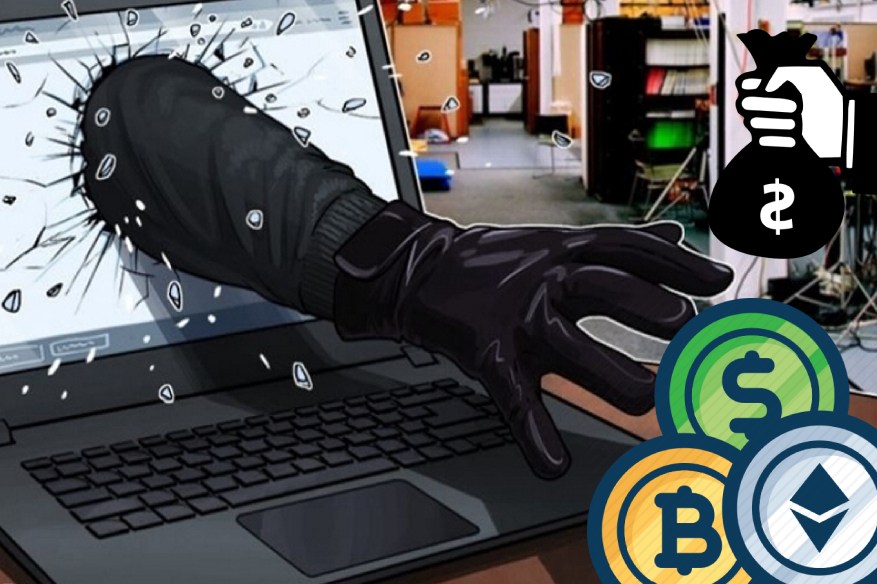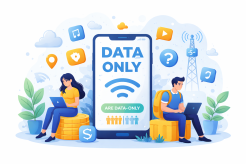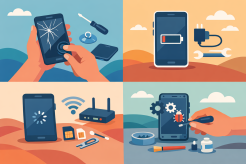Terrifying Cybercrime Figures

The internet allows us to connect with each other from all over the world, find the answer in a matter of seconds to almost every question, order food, get directions, send pictures, and so much more.
Yet just like anything else, with the internet, the good comes with the bad. And the "bad" in this situation is cyber-crime. Being so digitally linked exposes us to significant risks, particularly if we don't take steps to stay safe.
What is Cybercrime?
Cybercrime is defined as any crime committed by the use of a machine. This might imply another email scam where the "French Diplomat" asks you to wire him some cash so that he can obtain his visa to travel to the United States, but it could also be a direct attack on the company's data to try and steal account information and credit card numbers.
This could also include the selling of illicit products on the Web, such as alcohol or child pornography, as well as harassment, such as when pedophiles want to talk to children, or when people make fun of each other and cause harm to each other, often known as cyber bullying.
Undervalued Threat
Nonetheless, given the very real threat of cyber-crime, not enough people take it seriously. It is quite normal to find people using devices that are not locked in to protect their logins or to open questionable mail that can give cyber criminals so much access to their private information.
If you're one of those people who doesn't take cyber-crime seriously enough, below are some of unsettling data that will wake you up to the severity of the threat:
-
Each 39 seconds, there's a cyber-attack
The traditional computer is targeted every 39 seconds in one direction or another. It could appear in the context of a clear attempt at intrusion, a phishing attempt, or some other type of spam designed to infiltrate your device with malicious code, or malware.
Researchers lowered the protections on a number of computers to do this experiment and tracked how often they were targeted. Luckily, you should be able to avoid most of these threats and stay safe if you are using an anti-virus system and some common sense. But still, realizing just how many attacks are going on at any given moment is frightening.
-
Over the last year, 78 percent of U.S. companies have suffered a cyber-attack
While hackers are going to attack almost anyone, they mostly try to focus on companies and other organizations that have financial or personal information on file for individuals. Nonetheless, quite unexpectedly, hackers are primarily targeting medium-and small-scale businesses because, while larger firms have more information, they are using their greater resources to build better protections against cybercrime. Small scale businesses are unable to do this and are therefore potentially better goals.
-
Approximately 23% of Americans either have their credit card or financial information hacked by hackers or know someone they have
It is one of those stuff that you don't know until it does happen to you. It's going to be completely unpredictable. You're going to look into your bank account one day and see some receipts of things you clearly haven't accomplished.
In many other situations, you will make a claim with your bank or credit card company and get the money back, but this won't save you from the trouble of having to withdraw your ticket, wait for a new one, and then upgrade all your records. Therefore, you may never get back the peace of mind you lose when someone gets hold of your information.
-
Data breaches affected 30% of all U.S. users in 2018
We're going to give up our personal information to almost anyone, particularly if they agree to send us some new clothes or a new fancy gadget. This is not a bad thing in general. Companies that take credit card information or other sensitive information are generally very proud of their efforts to keep it secure, but no one can be completely free from cybercrime. That results into about one in three chances to be harmed by a data breach in a company with which you are doing business
In the first nine months of 2019, more than 1,000 data breaches revealed 147 million documents
When this doesn't make it hit home that cybercrime is a constant danger, nothing is going to happen. Luckily, our protections allow it so that most of these uncovered files, but not all of them, are not too vulnerable. Nonetheless, this rank will serve as a reminder of why the strongest possible defense is so necessary.
-
Every year, the number of data breaches is rising
No reason to think that this risk will go away if we just "ride it out." When more of the world goes online, there's more valuable information than ever, and cyber criminals have tremendous opportunities to try to break into a company's infrastructure to access your personal data along with that of hundreds, if not thousands, of others.
-
The variance in smartphone malware has risen by 54%
This is a position that reminds us of how hackers and other cyber criminals are constantly improving their methods of targeting us and stealing our data. Malicious software, which is a blanket term for the many different types of compromised computer hackers, is becoming more common, particularly for mobile devices.
When our dependence on our smartphones is considered safe from hackers, we have hackers developing lots of new software designed to get to our information. And this new malware is becoming more special, which means it's hard to identify and deter, which means we need to be constantly vigilant.
-
The United States ' economic cost of cybercrime ranges from $57 billion to $109 billion
Such cost comes from things including: paying back money lost for theft, compensating those who have been robbed from their identities, offering or losing money on false fronts, paying ransoms to eradicate viruses, and much more.
This isn't something that happens every once in a while and doesn't cause a lot of damage. However, as explained above, it is a constant threat that can have severe consequences, such as losing about $100 billion a year to the US economy.
-
The cost to the global economy of cybercrime is around $445 billion annually
Remembering this is not just an issue in the United States, it's critical. Cybercrime is a huge problem all over the world, with some countries having more issues than others. A good example is Indonesia where you have a risk of being hit by a cyberattack at 76 percent All these threats come with a price tag which cost nearly half a trillion in full to the global economy
-
In phishing, we just lose $1.48 billion
Phishing is the use of clever scammers to seek to get you to be the one to let them in any device they want to exploit or steal from you. Typically, they use email, but they can also call or text you and rely on you to click the link in the email that will cause a download to your computer.
Some emails may seem to be from someone you meet, or a complete stranger (like a Nigerian prince), asking for money to get them out of a sticky situation.
Yet we lose 1.48 billion a year to phishing attacks, indicating that many email users are not aware of the risks and/or that hackers are always finding new ways to trick us
-
Company loses nearly $1.6 million to tackle the effects of phishing attacks
When you own a company or work for someone who doesn't have a strong defense against cybercrime, this should be a call to action. It's not fun to get struck by a hacker. If your customer's information is compromised, you will have to pay to find out the problem, repair it and upgrade the process so that it doesn't happen again, reimburse those affected, and also try to restore your reputation and relationships
-
Estimated 60% of small businesses with cyber attacks are out of operation
When you own a company and think that spending $1.6 million to clean up after a cyber-attack will kill you, you're not alone. Nearly two-thirds of the businesses that fall victim to a hack or data leak end up having to close down. This may be due to the combination of not being able to manage the cost and also the loss of trust that comes with the loss of sensitive customer information.
-
Over the last three years, Americans have lost more than $1 billion in online dating scams
Surprisingly, one of the largest cybercrime incidents in the United States is online dating scams. In these cases, cyber criminals make fake accounts and then scan for people on different platforms. They flatter and court them, and then, at some point, they usually ask for some money to help them with a question. But then, after they send the money and request for a meeting, they never hear from the individual again.
Obviously, cybercrime is both pervasive and negative. But what's behind it? Are the attackers really so good at finding their way into these well-defended systems? Indeed, in some situations. But most of the time, they get hold of knowledge or other important details because we let them in!
-
The most common places for you to get hacked is your email and phone
Phishing tries sent to your inbox and your mobile via text message are the most popular way for you to get hacked. This might be a text that seems like it's originating from your bank or an attorney, but sometimes all you need to do is tap it and the machine has been hacked. Just double check the recipient data, and don't click when in doubt.
-
Estimated 39% of all malware-induced global data breaches are ransomware
Another explanation why cybercrime has such a huge impact on our economy is the use of ransomware. This is a kind of ransomware that essentially takes your computer hostage, threatens to erase or reveal your data if you don't pay a fee to someone who has "kidnapped" your files.
It should be a no-win situation because you don't just give up your bank details if you pay, and you might still not get back your data. When you don't pay you're going to be punished. Many companies don't pay ransoms, which is why so many of the data breaches that arise are triggered by this kind of malware.
-
Estimated 66% of all the malware compromised was spam and phishing
Phishing is the primary means attackers use to get you on your computer to download ransomware. Sometimes, they could use pop-up ads to get you to tap on something and install their software. They hope you tap on it while using a device with connections to a larger data network, but if they don't, they'll only take yours and seek somewhere else.
-
The current or former staff were liable for 56% of cybercrime perpetrated against businesses
To business owners, you should only know this stat once to training your employees to fight against cybercrime a priority. That's because this stat doesn't mean that you've all got workers out there who want to get you and steal your money. They simply don't know how to detect a phishing attack, or what to do if we think they've been attacked, so when it occurs, they make a mistake that will cost the company a lot of time. Prep first and you'll be grateful later.
There are many other forms of cybercrime that do not include data breaches, exploits, and knowledge regarding identities. Some of these other offenses do not even deal with cash. Alternatively, these are representations of what sick people can do with an internet connection.
Kids are particularly susceptible because they are unsure of how to identify a threat and what to do when it appears often.
-
About one in five teenagers using the internet obtained an unwanted sexual intercourse
When you think about it, this stat is quite terrifying. Kids are almost constantly online, mostly on social media and other platforms that help people to communicate with each other. The innocent person who shows the interest in the same stuff as them is often accepted, but this friendliness can then vanish when one side wants to talk or take pictures, placing the kid in a place of conflict.
Talk to your children about speaking to people they don't know about online to get them to develop good street smarts online to stay safe when browsing the web.
Related Posts

Fri, Dec 26, 2025 9:01 PM
cheap internet offersAre Data-Only Plans the Next Big Thing?
Explore why data-only plans are gaining popularity, their benefits for mobile users, and how they could change the way we stay connected.

Fri, Dec 26, 2025 6:01 PM
mobile phone plans5 Questions to Ask Before Signing a New Phone or Internet Contract
Before signing a phone or internet contract, ask these 5 essential questions to avoid surprises and choose the best plan for your needs.

Thu, Dec 25, 2025 11:16 PM
cheap internet dealsCommon Smartphone Problems and How to Fix Them Yourself
If you’ve tried all these phone troubleshooting tips and your device still struggles, it might be time to contact your manufacturer’s support or visit a certified repair center.

Tue, Dec 23, 2025 10:40 PM
cheap internet plansYour Upload Speed Might Be Slowing You Down—Here’s Why
Discover why your upload speed may be slowing down and how to fix it. Learn tips to improve your internet performance and avoid frustrating delays

Tue, Dec 23, 2025 2:15 AM
Internet BundlesDecoding Internet Coverage Maps: Tips and Insights
coverage map is a starting point — not the final answer. Combining map data with local feedback, independent tools, and personal testing gives you a far clearer picture of your true internet options.